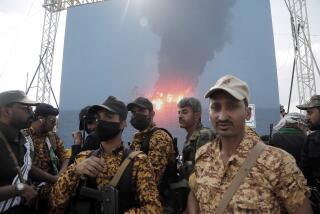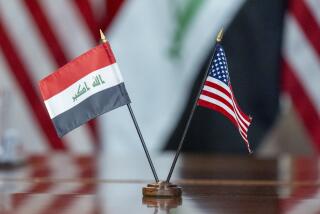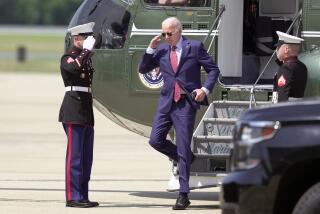U.S. Jet Fires Missile at Iraqi Antiaircraft Battery : Persian Gulf: Washington says plane was targeted by radar. Incident appears unrelated to strike against Baghdad.
WASHINGTON â A U.S. warplane fired a missile at an Iraqi antiaircraft battery Tuesday after being targeted by the Iraqi unitâs radar, but the incident appears to have been isolated and unrelated to the weekend U.S. attack against Baghdad, U.S. officials said.
The Pentagon said the attack by an Air Force F-4G Wild Weasel jet fighter occurred about 5:15 p.m. (6:15 a.m. PDT) in Basra province, inside the âno-flyâ zone that the allies have imposed over southern Iraq to protect rebel Shiite Iraqis from dictator Saddam Hussein.
There was no immediate word from U.S. sources about whether the Iraqi battery was damaged, but the Iraqi Foreign Ministry said that the missile hit its target and that one Iraqi soldier was wounded. It also contended that the radar unit had been âinactive.â
The Foreign Ministry branded the U.S. shooting an âunwarranted act of aggression.â
The incident, the first of its kind since mid-April, came only two days after the United States, retaliating for Iraqâs alleged attempt to assassinate former President George Bush in April, launched 23 Tomahawk missiles against an Iraqi intelligence complex in Baghdad. Iraq says eight civilians were killed in the U.S. raid.
Navy Capt. Michael Doubleday, the Defense Departmentâs acting spokesman, said it was too early to tell whether gunners in the Iraqi antiaircraft unit had simply acted reflexively or were purposely testing allied resolve.
The Iraqi gunners aimed their targeting radar at the American planes--a step that usually is taken just before an antiaircraft crew fires at a warplane. The targeting radar helps them aim their guns more precisely.
âItâs premature to attach any particular significance to this event,â Doubleday said. âWe have had these incidents before.â
U.S. warplanes and Iraqi antiaircraft batteries have been involved in several incidents similar to Tuesdayâs during the last 6 1/2 months, with American pilots routinely dropping bombs or missiles whenever their aircraft are targeted by Iraqi radar.
President Clinton, asked about the shooting during a press conference at the White House, sought to minimize the incidentâs significance, saying that the attack was carried out under âstandard rules of engagement.â
âIf radar locks onto our airplanes, our airplanes are authorized to take action,â the President told reporters. âThis has happened a number of times. I wouldnât read too much into it.â
The developments came as two U.S. warships--the aircraft carrier Theodore Roosevelt and the destroyer Spruance--sailed through the Suez Canal en route to the Red Sea, where they have been assigned to help enforce the southern Iraq âno-flyâ zone.
Their arrival will bring the number of U.S. warships in that area to six, including another destroyer, two frigates and an auxiliary vessel. Until now, the Roosevelt had been in the Adriatic Sea, helping to enforce a separate âno-flyâ zone over Bosnia-Herzegovina.
The shooting involving the U.S. F-4G occurred amid continued tension in Iraq following the American Tomahawk strike Sunday.
Iraqi spokesmen confirmed that, in a separate incident Tuesday, nervous Iraqi antiaircraft gunners apparently misidentified an Iraqi plane as American and unleashed a fusillade of antiaircraft shells at it. There was no immediate indication as to whether the aircraft was hit.
âWhen the other antiaircraft gunners heard the firing, they joined in,â a spokesman at Dar Salam radio, run by Husseinâs son, Uday, told the British news agency Reuters.
Iraqi newspapers speculated Tuesday that the United States would launch another missile attack soon because of Baghdadâs apparent refusal to permit the United Nations to install monitoring cameras at Iraqi missile test sites.
The government newspaper Al Jomhuriya said Clinton âknows very well that the months ahead will be filled with trouble for his troops abroad, here (in the Persian Gulf), in Africa and everywhere,â according to the Associated Press.
And Qadissiyah, the Defense Ministryâs newspaper, said Iraq should strike hard against not only âthe United States, but also Israeli, Saudi Arabian and Kuwaiti targets all over the world.â
U.N. sources in Baghdad told Reuters that the Iraqis are taking the dispute over the cameras seriously and are evacuating equipment from strategic installations.
Even so, U.S. officials said they had no evidence of any hostile activity other than the radar lock-on or of major troop movements in Iraq and indicated that the Iraqis have stopped repositioning their air-defense units to avoid attack, as they did following Sundayâs attack.
In Geneva, despite the confrontation that led to Sundayâs raid, the United Nations announced that it will resume high-level talks with Iraq next week on whether Baghdad should be permitted to resume selling limited amounts of oil.
The United Nations wants to persuade Iraq to sell some oil to help cover the cost of U.N.-provided humanitarian aid in the wake of the 1991 Persian Gulf War, but Baghdad has remained unwilling to do so.
U.N. spokeswoman Therese Gastaut said that the next round of talks will take place in New York on July 7.
Allied Clashes With Iraq Since Persian Gulf War
Clashes between U.S.-led allies and Iraq since 1991 Gulf War:
* March 20, 1991--Iraqi Sukhoi 20 fighter-bomber shot down by U.S. F-15 over northern Iraq when it defied ban on military flights.
* March 22--Iraqi Sukhoi 22 fighter-bomber, apparently on a mission to attack Kurdish rebels, destroyed by F-15 over northern Iraq.
* Dec. 27, 1992--Iraqi MIG-25 shot down by U.S. F-16 over southern Iraq when it entered âno-flyâ zone imposed by allies below 32nd Parallel.
* Jan. 13, 1993--116 U.S., French and British warplanes launch nighttime raid on eight surface-to-air missile sites in southern Iraq, destroying four. Iraq reports 19 people killed, including two civilians.
* Jan. 17--Iraqi MIG-23 shot down over âno-flyâ zone in northern Iraq by U.S. F-16. Allied warplanes attack missile site in north. U.S. warships in Persian Gulf and Red Sea fire 45 cruise missiles at nuclear-related facility at Zaafaraniyah near Baghdad; 37 hit targets, one apparently hit by antiaircraft fire hits Rashid Hotel in central Baghdad, killing at least two civilians.
* Jan. 18--In first major daytime assault since war, 75 U.S., British and French warplanes hit Iraqi missile sites that survived Jan. 13 raid. U.S. and British jets bomb missile batteries in north. Iraq says 21 dead. Iraqi MIG-25 in north hit by air-to-air missiles fired by U.S. F-15. Kill not confirmed.
* Jan.19--U.S. and British jets attack air defenses in north after they come under fire. Washington deploys aircraft carrier John F. Kennedy to eastern Mediterranean.
* June 27--U.S. fires 23 Tomahawk missiles at Baghdad, killing at least eight, to retaliate for alleged Iraqi plot to assassinate former President George Bush in Kuwait in April.
* June 29--U.S. jet monitoring âno-flyâ zone in southern Iraq fires a missile at an Iraqi antiaircraft radar unit.
Source: Times wire reports
More to Read
Sign up for Essential California
The most important California stories and recommendations in your inbox every morning.
You may occasionally receive promotional content from the Los Angeles Times.










